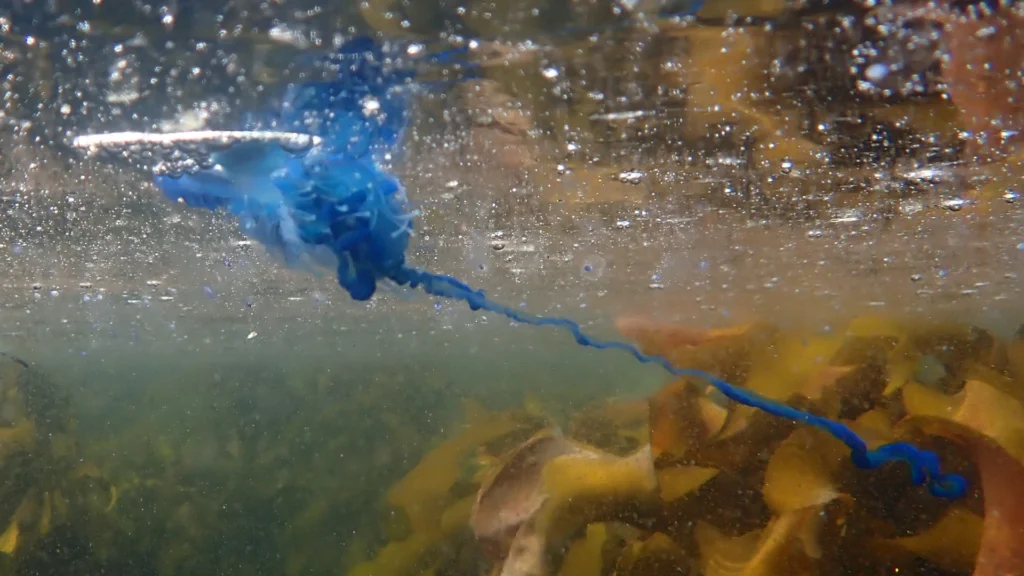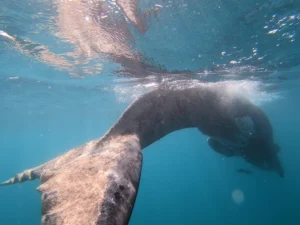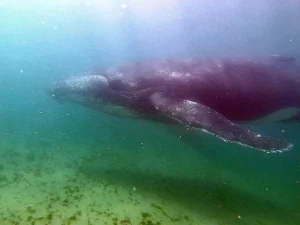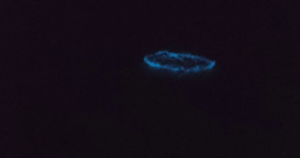The Portuguese man o’ war (Physalia physalis), commonly known as the bluebottle, is a marine organism often mistaken for a jellyfish. It is, however, actually a colony of specialised animals known collectively as a siphonophore. Siphonophores consist of four distinct organisms, known as polyps or zooids, that function together. The Portuguese man o’ war namesake stems from the close resemblance of the bluebottle to the 15th century Portuguese warship. These fascinating hydrozoans can be found in tropical and subtropical waters across the Indian, Atlantic and Pacific Oceans.
Bluebottles are distinguished by their gas-filled float, known as a pneumatophore, which functions as a buoyancy control chamber and an anchor point for the remaining three polyps; gastrozooids, which are responsible for digestion and capturing prey; dactylozooids, or tentacles, which serve as defence and to immobilise prey; and gonozooids, which are involved in reproduction. Bluebottles are diecious and therefore each colony is either female or male. Sexual reproduction occurs when the colony releases sperm or eggs into the water for fertilisation to take place. Once fertilised, bluebottle eggs develop into larvae that grow new zooids, and gradually form new colonies.

As pelagic organisms, bluebottles are commonly found floating on the surface of the water, propelled by wind and ocean currents. Thus, they form part of a community of surface-dwelling marine organisms known as neuston, which inhabit the confluence between the ocean and the atmosphere. Neuston are extremely specialised to withstand the harsh environmental conditions of extended exposure to sunlight, wind and rough oceanic conditions.
Bluebottles cannot move independently; their distribution is influenced by factors such as wind, water temperature, salinity, and nutrient and prey availability. As carnivores, bluebottles primarily feed on small fish and larvae, plankton, and invertebrates. Their tentacles bear numerous stinging cells called nematocysts, which inject venom into their prey, immobilising them and enabling capture. Once caught, the gastrozooids help digest the prey and distribute nutrients throughout the colony. Despite the bluebottle’s venomous tentacles, some species remain undeterred, with its primary predators being sea turtles and ocean sunfish. In addition, the blue sea dragon (Glaucus atlanticus), is a nudibranch that feeds predominantly on bluebottles, and in turn stores the venomous nematocysts to use as its own defence against predators. The nematocysts that are used to paralyse the bluebottle’s prey can also result in a painful sting for humans who encounter their tentacles. Stings cause contact dermatitis resulting in painful red welts. Vinegar is said to be an effective treatment, with most stings subsiding within a few hours.
Dive into the enchanting marine world with Cape Town Freediving and potentially encounter the captivating bluebottles, a fascinating but understudied component of the marine environment. These remarkable creatures, not yet evaluated by the IUCN, offer a wealth of knowledge yet to be uncovered. While caution is advised due to their venomous stings, their beauty and intricate connections will leave you in awe. Join Cape Town Freediving for an unforgettable snorkeling or freediving adventure, where you can gain a deeper appreciation of the wonders that the ocean holds.



